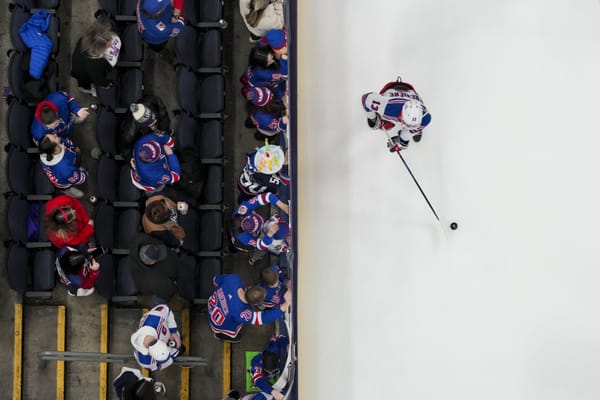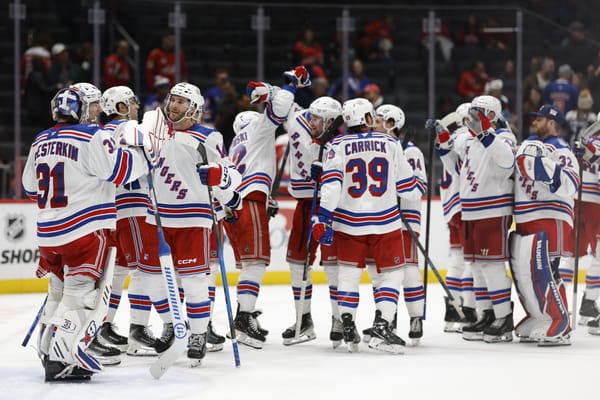An Early Look at How Vladimir Tarasenko’s Played for the New York Rangers
Vladimir Tarasenko has skated in 12 games with the New York Rangers since being acquired from the St. Louis Blues, and with the team off until Thursday, now is a great time to take a quick look at how he’s played. At the time of the trade, Tarasenko was in the midst of a down season with a Blues team that wasn’t playing all that well, and many hoped that putting him on the Rangers’ roster would reinvigorate his game.
New York has gone 6-5-1 since Vladimir swapped the blue note for a Blueshirt, but has the move been a productive one thus far?
Basic Stats
4 goals, 5 assists, 9 points, 21 shots on goal, 16:17 ATOI
Advanced Stats
2.76 points/60 | 54.13 GF% | 39.5 CF% | 42.41 xGF% | 1.4 GAR via Evolving-Hockey
Since joining the Rangers it has been a bit of a mixed bag for Tarasenko as he’s found a way to produce on the score sheet, but the underlying numbers haven’t been that great. On his 9 points, 2 have come on the power play, and the remaining 7 have come at even strength. His overall points per 60 is up .14, and his points per 60 at 5v5 is up .35.
When looking at the offensive heat map, the red areas show where Tarasenko’s been generating offense, which unsurprisingly is near the front of the net off to the side, and on the right side after crossing the blueline. The defensive heat maps also show a lot of chances from his side of the ice, something that could be a coincidence or a distinct choice from teams looking to exploit a matchup.
Tarasenko had a line of 2-6-8 in 12 games prior to joining the Rangers, so it is encouraging to see that he’s picked up his goal scoring a bit since joining the Rangers.
Tarasenko 🥵 pic.twitter.com/CCH0gqAH3C
— Shayna (@hayyyshayyy) March 3, 2023
Vladimir Tarasenko - It's A Winner!!!
— Rangers on MSG (@RangersMSGN) March 2, 2023
Rips one in OT for the GWG in Philly 🚨 pic.twitter.com/B9hi3P0yZd
What I don’t like is the subpar underlying numbers, but it important to remember that it is only a 12-game sample size. That said, I still think it is important to try and understand why they are as poor, if there’s something putting Tarasenko at a disadvantage, or if he’s been the reason things aren’t working.
Before drilling down on the numbers, I believe part of his struggles are a byproduct of him being moved around a bit at 5v5 which has forced him to try and gain chemistry with multiple players at once. The Rangers are good when it comes to pairing their defenders and leaving them alone, but sans the trio of Lafrenière, Chytil, and Kakko, there have been quite a few forward combos this season.
Another reason is that collectively the Rangers’ defensive structure as of late has been nonexistent. Some of that is a consequence of a tough schedule going to the West Coast and then returning without being able to get their legs underneath them. There’s also the fact that the team has been playing shorthanded for salary cap reasons, but in general there’s been a bit of a dip in effort on the little things like supporting the defense, making the extra effort in the neutral zone, and just losing battles that were won earlier in the year. In any case, here’s how Tarasenko’s been utilized since joining the Rangers.
Chris Kreider | Mika Zibanejad | Vladimir Tarasenko
5v5 TOI: 78 minutes
Slash Line: 76.32 GF% | 30.56 CF% | 35.84 xGF% via Evolving-Hockey
This has been the primary trio that Tarasenko’s been part of, and this is a situation to monitor going forward. The addition of Patrick Kane was made possible with some creative accounting, and I wonder how heavily these numbers are skewed by playing shorthanded. In any case, this is a trio that hasn’t quite found it’s footing, and has a lot of work to do. With that said, here’s a look at the on ice-impacts thus far via HockeyViz.com
Luckily there’s enough regular season games left, but in the long run I do wonder if Gallant will break up this line and add a winger with a bit of a proven track record with Kreidbanejad. The subpar offensive generation and simultaneous conceding against is concerning, especially since this has seen them spend a good amount of time with Adam Fox also on the ice. This is something to keep an eye on, especially once the team is back to 18 skaters in the lineup.
Offensively Kreider is a player who can score off the rush, but he tends to find himself trying to deflect pucks from the net front. Tarasenko’s been dangerous historically when he’s set up to shoot, and it’s possible that his style clashes a bit with Kreider. Zibanejad is more of a mixed bag who is pretty even this year in terms of goals scored and assisted on, and you’d think there’s an opportunity to set Tarasenko up with some royal road chances, meaning pucks that cross the imaginary line drawn from the goal in between the circles. This is something to monitor going forward, as this is where Gallant seemingly wants to keep him for now.
Artemiy Panarin | Vincent Trocheck | Vladimir Tarasenko
5v5 TOI: 44 minutes
Slash Line: 49.62 GF% | 54.16 CF% | 57.14 xGF% via Evolving-Hockey
This combination is a line that should probably still be together given how well it possessed the puck and generated chances, even though the actual numbers didn’t quite matchup. It feels pretty balanced by having a playmaker, and two-way center, and a sniper that will shoot at will.
Furthermore, Tarasenko isn’t a strong defensive forward, and some of that can be mitigated by having a center like Trocheck who historically has delivered competent results. Panarin at times has shown himself to be a standout defensive forward, when he wants to be, but his ability to get the puck moving up the ice helps limit chances against by getting the Rangers started on the counter attack. Here’s a look at the on-ice impacts of this line via HockeyViz.com
The red on this chart is tilted toward Tarasenko’s side of the ice which is a by-product of Panarin looking to connect with him via a cross-ice pass going over the royal road. This is utilizing Tarasenko’s strength which is shooting the puck, something that a lot of recent notable additions showed a hesitancy to do.
The end of this line started following a 6-3 loss vs. the Washington Capitals, and since the Patrick Kane trade was made #88 has played with Panarin and Trocheck. I do wonder if it is something Gerard Gallant will go back to if Kane gets a look on the top line with Kreider and Zibanejad. Kane might actually be a better fit here in the long term, and we could see that in the coming weeks if Gallant moves him around like he did Tarasenko to start his tenure with the Rangers.
Artemiy Panarin | Mika Zibanejad | Vladimir Tarasenko
5v5 TOI: 21 minutes
Slash Line: 48.7 GF% | 40.07 CF% | 54.55 xGF% via Evolving-Hockey
This is the line Tarasenko first played on, and it only took him a few minutes into his debut to connect with Panarin for a goal vs. the Seattle Kraken. This line was broken up after a poor game vs. the Carolina Hurricanes, and new lines debuted during the Rangers’ game in Vancouver vs. the Canucks.
I don’t necessarily think this line should have had such a short leash, but I do wonder if there was some things Gallant looked at and realized they were capable of, and wanted to learn more about other potential combinations. It also could have been a case where the team didn’t want to overload their top line, but as you saw above the team did keep Panarin and Tarasenko together on the second line.
This very much feels like a “break glass in case of emergency line”, as it takes a wing pairing that can feed off each other, and has a great center in Zibanejad. I am willing to be there’s more offensive capabilities to be realized, and it was good to see that defensively it wasn’t a tire fire in the short sample.
The Rangers as of late have been a mixed bag, and we simply need some more time with the new group playing together with a full lineup. I think the early returns on Tarasenko are positive, and as he becomes more comfortable he’ll continue to produce. If I had to assign a letter grade, I would say he’s been a B- player.
Finding an environment that minimizes his defensive shortcomings is key, and the Rangers were trending in the right direction when he was on a line with Panarin and Trocheck. That’s something that can allow him to focus on his strengths, which is being a lethal goal scorer.
The Rangers have the luxury of time to experiment, and that’s something they will likely continue to do. We’ve seen them already move Tarasenko around, and the addition of Kane should result in some more experimenting once he’s had a bit of a run himself.
Whenever you add a new player to the lineup, there’s no telling how quickly they will assimilate and in turn produce. Tarasenko scored minutes into his debut. Patrick Kane has gone pointless in two games, and nine years ago the Rangers traded for Marty St. Louis and it took him 15 games to score his first goal as a Blueshirt.
In a short span we’ve seen bits and pieces of Tarasenko’s explosiveness that made him such a dominant player in St. Louis, and it is great to see that he’s gotten more involved as time has gone on. The key will be coming out of this mini break with fresh legs, and getting off to a hot start in the games coming out of the break. It is going to be a sprint to the finish, and Tarasenko is someone the team will be counting on. He’s got the tools to be a big factor, and it is up to the coaching staff to make sure Tarasenko is put in a position to have the biggest potential impact.





